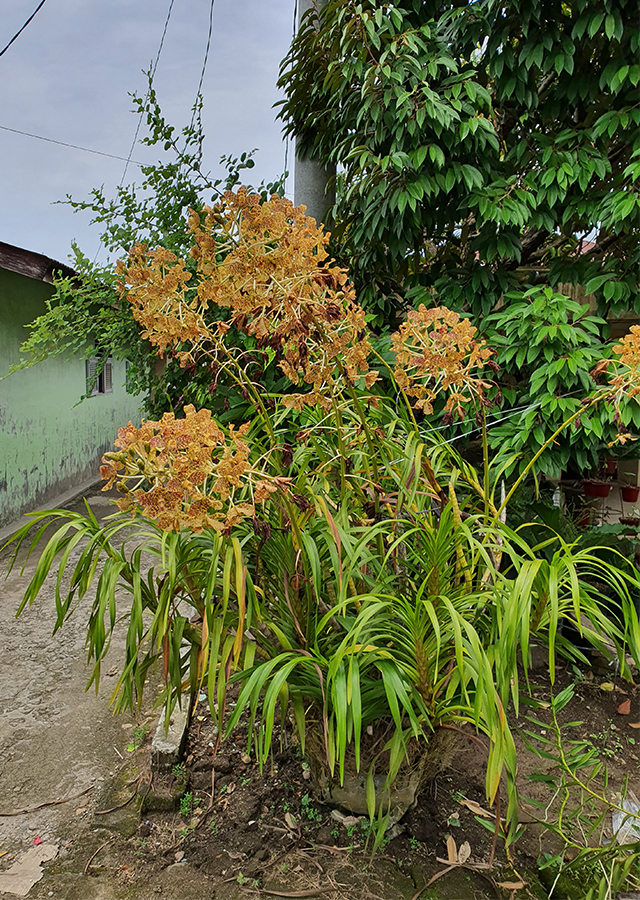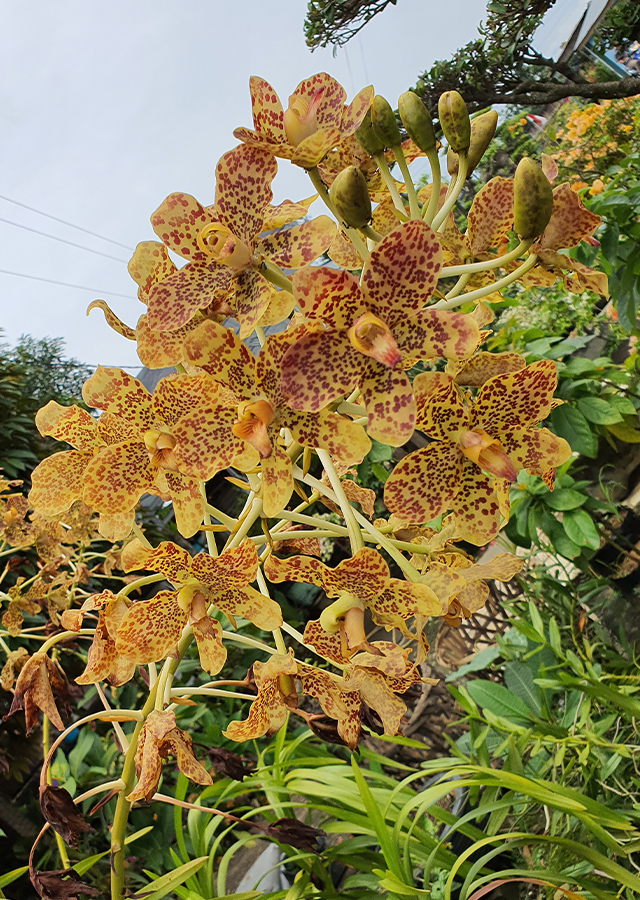Traditional Herbs from Grammatophyllum speciosum
treat_cracked_skin_on_the_heel
- Take the stem\u00a0of the fan orchid and wash it until clean.
- Cut\u00a0the round stem then rub\u00a0on the heel to treat the crack.
hepatitis
- Take the root of the fan orchid, wash it until it is clean.
- Boil the roots until boiling.
- Let it warm/cool.
- Strain and drink.
What is Grammatophyllum speciosum Looks like??



Parts of Grammatophyllum speciosum that could be used
- Leaf
- Stem
- Pseudobulb
Grammatophyllum speciosum Distribution
Grammatophyllum speciosum or what is known as the 'Queen of Orchid' is the largest and heaviest orchid species among other types of orchids in the world, originating from Southeast Asia (Indonesia, Laos, Malaysia, Myanmar, Thailand, Vietnam). It has also been recorded as being found in the Philippines, Papua New Guinea, and the Solomon Islands. In Indonesia, this plant is spread across Kalimantan, Sumatra, Java, Sulawesi, Maluku and Papua. Grammatophyllum speciosum has attractive foliage and flower patterns as well as large flower sizes, making this plant much sought after and cultivated as an ornamental plant. In Indonesia, this type of orchid is one of the orchid plants whose existence is starting to become rare and is a type of orchid that is protected by the government, based on Government Regulation of the Republic of Indonesia number 7 of 1999, on January 27 1999. Ecological disturbances in the form of forest conversion and over-exploitation , threatens the existence of G. speciosum populations in nature. Apart from its beauty, this species apparently has a function as a medicinal plant, which has been used traditionally by the Papuan people to treat several diseases, such as cysts. The results of other studies also show that this species has pharmacological activity, where the 6 year old rhizome + root extract of G. speciosum has the potential to be a source of natural antidiabetic drugs and the 6 year old leaf and 6 year old rhizome + root can be a source of antioxidants. In Indonesia, sometimes parts of this orchid flower can also be used as hair decoration.Agroecology of Grammatophyllum speciosum
Grammatophyllum speciosum is an epiphytic plant that is often found growing on the branches of large trees in lowland tropical rainforests and areas with tropical climates, at an altitude of up to 550 m above sea level. This species requires direct sunlight, but also does well in partial shade. The best temperature needed by this species is 21 °C at night and 27 - 30 °C during the day. Dry weather can trigger mass flowering.
Morphology of Grammatophyllum speciosum
- Fibrous roots. There are two types of roots, namely thick (sticky) roots that grow downwards/into the media and small roots that grow through the surface of the media.
- Thick, long and fleshy stems, with nodes, shaped pseudobulb. Sympodial growth type. Stem structure is similar to sugarcane plants.
- Large leaves, without stems, arranged in two rows, drooping from the base when mature. Leaf blades are linear, can reach up to 35 cm in length, thin, narrowed and curved downwards towards a sharp tip, leaf margins are flat, green.
- Flowers are large (up to 10 cm in diameter), resting on shoots extending from the base of the stem. Sepals and petals are pale greenish yellow with orange spots -brown, turns darker as it matures. Labellum (lip) yellow, three-lobed, with red-brown veins on side lobes and red-brown markings on middle lobe, disc decorated by three short ridges. The flower stalk is about 2 m high and bears about 40 long-lasting flowers (can even more). The aroma of the flowers is fragrant.
- The fruit is pear-shaped, brown when ripe.
- The seeds are very small, numerous and do not have endosperm (food reserves).
Cultivation of Grammatophyllum speciosum
- Propagation in two ways, namely vegetative (breaking or separating clumps, tissue culture) and generative (seeds).
- Vegetative propagation by separating seedlings can produce daughter plants that have the same genetic characteristics as the parent, but this method is not practical and The number of seedlings obtained is very limited. Meanwhile, tissue culture propagation can produce uniform plants in large numbers and in a relatively short time.
- Best grown as an epiphyte, but can also be planted in the ground or in large containers. To grow it as an epiphyte, it can be tied to the trunk of a large tree.
- Mature plants, can flower every two to four years, with flowers lasting up to two months.\u00a0
Grammatophyllum speciosum, more details :
Chemical Content of Grammatophyllum speciosumGlucosyloxybenzyl derivatives, grammatophyllosides, cronupapin, vandateroside II, gastodin, vanilloloside, orcinol glucoside, and isovitexin.
Benefits of Grammatophyllum speciosum
Treating snake bites, scorpion stings and centipedes, treating myomas or cysts, hepatitis, eradicating stomach worms, reducing fever, contraceptive drugs, speeding up the healing process of wounds and skin cracks on the heels, increasing body endurance, treating muscle pain, brightening the skin, overcoming mouth ulcers and bad breath. Has antidiabetic and antioxidant activity.
Simplisia of Grammatophyllum speciosum
Another Facts for Grammatophyllum speciosum :
Synonym of Grammatophyllum speciosumGrammatophyllum fastuosum Lindl., Grammatophyllum macranthum (Wight) Rchb.f., Grammatophyllum giganteum Blume ex Rchb.f.
Habitus of Grammatophyllum speciosum
Orchid. Large, epiphytic, annual orchid, reaching up to 7 m in height
Habitat of Grammatophyllum speciosum
- Forest
- Land
No comments:
Post a Comment